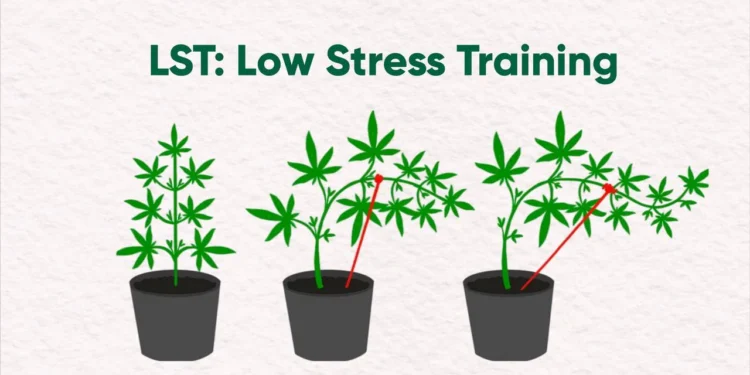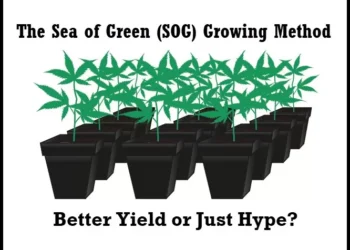The Low-Stress Training (LST) method uses light bending and branch securing to produce flat wide growth patterns in plants. LST enables growers to develop multiple colas and achieve optimal light penetration especially beneficial for indoor and confined gardening areas.
The Rise of LST as a Preferred Training Method for Cultivators
Growers adopt LST because it offers straightforward implementation while saving costs while delivering higher yields while maintaining plant integrity. The method works with every strain type and setup configuration. The training system offers straightforward implementation for beginners to achieve professional-level plant growth.
Marijuana is not a drug. It’s a leaf.
Arnold Schwarzenegger
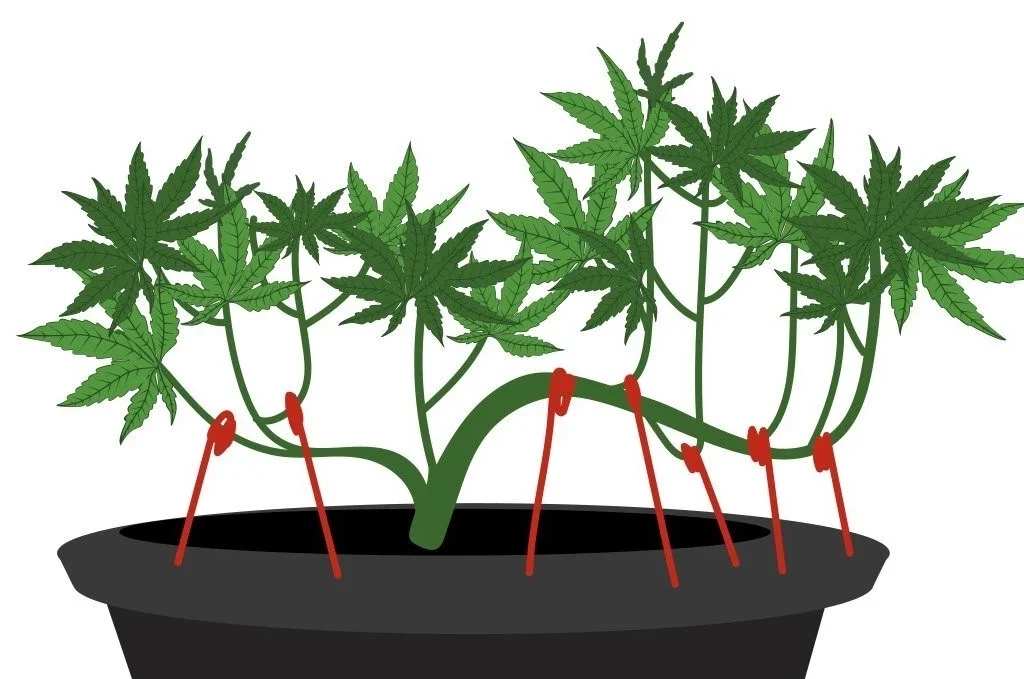
Benefits of Low-Stress Training
Improved Light Penetration
Low-Stress Training allows all areas of the plant to receive light by distributing illumination beyond the main top buds. The plant receives balanced energy distribution which enhances its operational efficiency.
Increased Yields
LST produces multiple main bud sites instead of one large cola. Each plant yields greater harvest weight from its total bud sites.
Better Use of Grow Space
The method is particularly valuable for indoor tents because it enables horizontal growth and effortless height management.
Enhanced Airflow and Reduced Mold Risk
The open plant canopy enables better airflow which minimizes both mold growth and pest hiding areas that form in dense plant leaves.
How LST Works The Science Behind It
Understanding Apical Dominance
When growers bend the tallest tip of the plant downwards they redirect auxin hormone distribution to enable side shoots to grow more vigorously.
How Plants Respond to Bending and Manipulation
Hormonal Redistribution in Plants
When gardeners lower the main stem the auxins will transfer to the side shoots which results in stronger development. The result? LST creates bushes with abundant productive top growth.
Energy Redistribution for Optimal Growth
The redistribution of nutrients through LST prevents one dominant branch from obtaining all the resources available to the plant so bud sites across the entire plant receive equal nourishment.
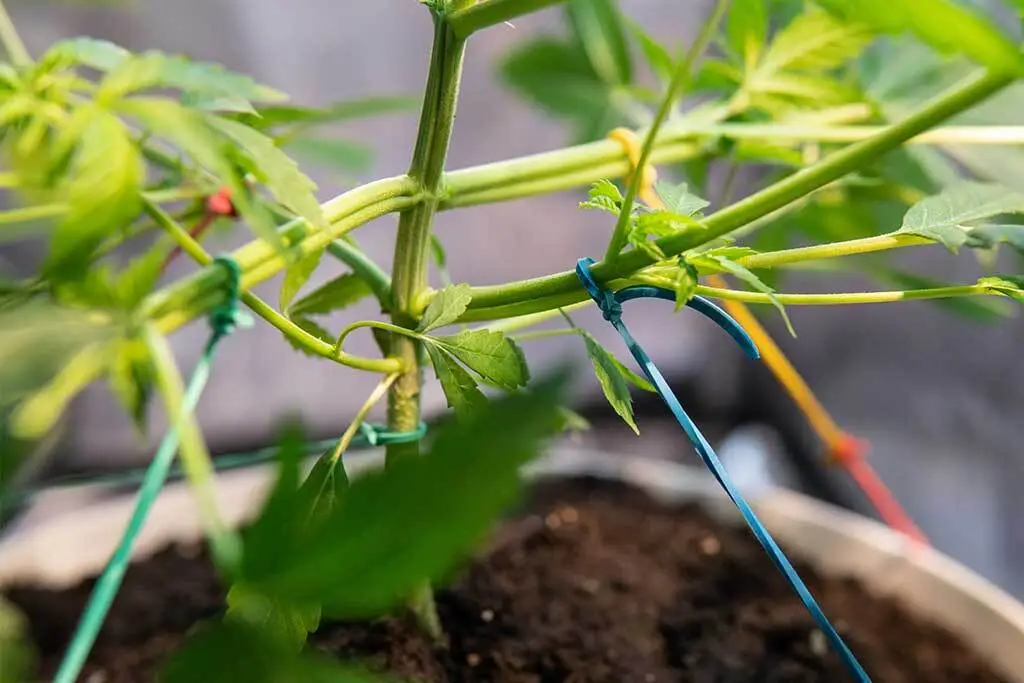
When to Start LST
Ideal Plant Age and Growth Stage
Start applying LST when your plant reaches 4–6 nodes and remains pliable during the early vegetative growth stage.
Signs Your Plant is Ready
Your plant will be ready for LST when it develops strong roots and healthy leaves and its central stem remains non-woody.
Tools and Materials for LST
Basic Essentials You’ll Need
Soft ties or pipe cleaners
– Anchor points (pot handles or stakes)
– Scissors
– Patience and a steady hand
Optional Tools to Make It Easier
Garden training clips
– Twist ties
– Plant wire
– Fabric pots (easy for tying down)
Step-by-Step Guide to LST
Step 1 – Identify the Main Stem
Begin by selecting the tallest shoot because this will receive your first bending operation.
Step 2 – Gently Bend and Secure
You should bend the stem with a slow pace then tie it down sideways. The bending process should be gentle without any sharp movements or excessive force.
Step 3 – Repeat and Monitor Growth
Check every few days. Examine your plant growth every few days while you maintain the training and modify the ties as needed.
Step 4 – Train Secondary Branches
When side shoots become visible you should bend and secure them using ties to allow their growth. The procedure leads to an expanded plant canopy.
Step 5 – Maintain the Canopy
Aim to keep everything at the same height. This setup produces uniform light distribution across the plant while promoting balanced growth.
LST Techniques for Indoor vs Outdoor Growing
How LST Differs Indoors
Growers working indoors train their plants to occupy vertical space while fitting under the available light range. The Low Stress Training method helps maximize the usage of each available square meter under your grow lights.
Adapting LST for Outdoor Gardens
Outdoors, sunlight moves throughout the day. The use of LST helps branches to grow outward while receiving light from various directions. Wind stress should be a major concern when using this technique.
Common Mistakes in LST and How to Avoid Them
Breaking Stems
Don’t rush. Always bend slowly and support the stem while tying it down.
Overtraining Too Early
Let the plant grow a bit before starting. A weak stem won’t respond well and may snap.
Ignoring Plant Recovery Time
Give your plant time to adjust by spreading out your training sessions. The plant will become stressed if you overdo it.
LST vs Other Training Methods
LST vs High-Stress Training (HST)
HST methods include plant pruning or pinching. LST achieves its goals through gentle plant manipulation which produces similar outcomes with less danger.
LST vs Topping
The main stem needs to be cut through topping to encourage side growth. LST provides the same effect as other methods without any stem cutting.
LST vs SCROG
The SCROG system trains plants through mesh screens. The method provides more adaptability because it operates without needing a net or frame.
Best Cannabis Strains for LST
What to Look for in a Strain
Choose plants that are naturally bushy, quick to recover from stress, and not too tall. Indica-dominant hybrids are great candidates.
Top Strains That Respond Well to LST
– Blue Dream – Fast-growing and forgiving
– Gorilla Glue – Strong branches and high yield potential
– Northern Lights – Compact and ideal for small spaces
– White Widow – Responds quickly to training
– Girl Scout Cookies – Thick buds with proper training
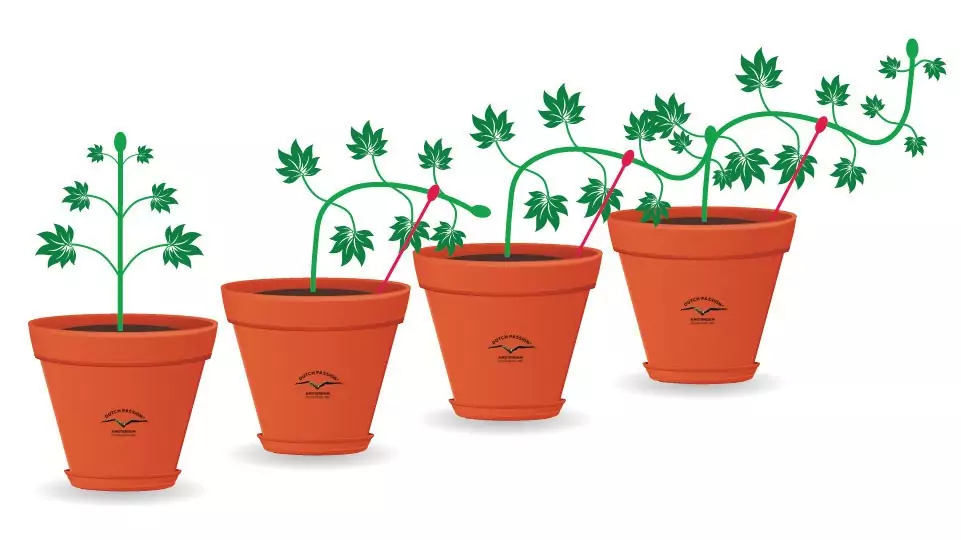
LST for Autoflowers
Special Considerations
Autoflowers have limited vegetative time, so you must begin LST early—around week 2 or 3.
Timing and Gentleness Are Key
Be delicate. Autoflowers don’t have much recovery time before they start flowering.
LST and Nutrient Management
Feeding During Training
Stick to your veg feeding schedule. Watch for signs of stress and adjust if needed.
Supporting Recovery with the Right Nutrients
Use calcium, magnesium and nitrogen-rich nutrients which support faster plant recovery following each training session.
Monitoring Progress and Making Adjustments
Watching for Stress Signals
Drooping leaves or slowed growth can mean you’re pushing too hard. Ease off if the plant seems tired.
Encouraging Lateral Growth
Cutting tips and bending vertical growth toward the outside will promote a flat canopy shape which helps with canopy control.
Harvest Results from LST
Comparing LST vs Untouched Plants
LST-trained plants produce 20-50% more yield than untrained plants. More bud sites result in additional harvestable product at harvest time.
Real-World Yield Increases
Growers typically achieve double the autoflower harvests and photoperiod plant harvests increase substantially when applying basic LST techniques.
Conclusion
Low-Stress Training is a game-changer for home growers. A smart, gentle, effective method to increase yields without spending money on expensive equipment or using risky methods exists. LST helps you grow smarter—not harder whether you’re indoors or outdoors. You will unlock your plant’s full potential by bending those branches with your soft ties.
Read More Article: Blue Dream Strain
